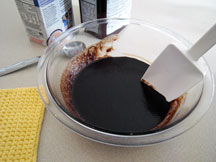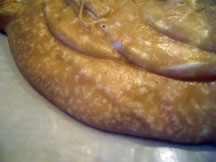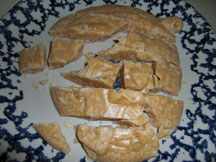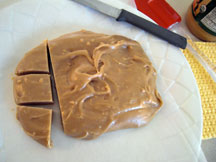Here are some details that will help you get the best results from your fudge-making
efforts. You can click on a question to jump directly to a topic, or read
all the topics below.
Doubling the Chocolate Fudge recipe that does
NOT have marshmallow is difficult. Whether cooking in microwave or on stove
top, batches turn out unpredictably. It takes approximately 20 minutes to make a
SINGLE batch of microwave fudge, and when trying to cook a double batch of this
recipe, it took 30+ minutes to make, and I never really got a good result (too soft-twice,
too hard-once, and never got a good creamy batch). If you're going to all
that work, I'm sure you'd like the fudge to turn out, so I suggest making two single
batches (microwave), just remembering to wash off the bowl and cooking spoons/spatulas
between batches.
For the Chocolate Fudge with Marshmallow
and the Peanut Butter Fudge, making a double
batch in the microwave is difficult. Stirring is long and the product is unpredictable.
I don't recommend it, but you can try it. Use a 2 liter bowl or larger (to prevent
boil-over), double all ingredients (except milk, reduce by 1 Tablespoon), and cook
until fudge reaches 225 degrees (don't forget to scrape down the sides of the bowl
at some point during cooking with rubber spatula). Add marshmallow and vanilla (or
peanut butter for the PB Fudge) and stir (I'd use an electric
mixer, ON LOW SPEED to avoid splashing). You may need to stir as long as
10 minutes (hence the need for the mixer), then pour onto wax paper.
Cooking fudge on the stove top is the method I recommend for doubling a batch...
good results are typical. Here are the recipes for the doubled batches:
- 1/3 Cup cocoa
- 1/3 Cup oil
- 3/4 Cup rice, soy, or almond milk
- 2 Cups granulated sugar
- 1/4 Teaspoon salt (scant)
- 1/2 Cup marshmallow cream OR 60 mini-marshmallows
Combine cocoa and oil in 2.5 Quart or larger stainless steel or aluminum saucepan
(can't use beaters in a non-stick saucepan). Add the rest of ingredients. Over SLIGHTLY
higher than MEDIUM heat, cook fudge, stirring often, until it reaches 230 degrees
on a candy thermometer. Remove from heat and add marshmallow and vanilla. Because
stirring fudge can take up to 10 minutes until its ready to pour, I suggest
using an electric mixer to stir (on LOW speed, to avoid splashing; don't
use higher speeds, or you'll end up with frosting!). Also, to speed cooling,
you can use a cool water bath for sauce pan: In a METAL dish (round, square, or
9x13 cake pans work), fill pan half-way with water and set pan in water - this cools
the fudge quicker...less stirring! (NEVER use this cooling method with a glass
bowl because, as in microwaving, the glass could break!) When fudge looks
close to pouring (fudge gets VERY thick), add nuts, if desired. Pour when ready
on wax paper and cool.
- 1/3 Cup oil
- 3/4 Cup plus 2 Tablespoons rice, soy or almond milk
- 1 Cup brown sugar (packed)
- 1 Cup granulated sugar
- 1/4 Teaspoon salt
- 1/2 Cup natural peanut butter
Combine all ingredients, except peanut butter, in 2.5 Quart or larger stainless
steel or aluminum saucepan (can't use beaters in a non-stick saucepan). Over SLIGHTLY
higher than MEDIUM heat, cook fudge, stirring often, until it reaches 230 degrees
on a candy thermometer. Remove from heat and add peanut butter. Because stirring
fudge can take up to 10 minutes until its ready to pour, I suggest
using an electric mixer to stir (on LOW speed to avoid splashing; don't
use higher speeds, or you'll end up with frosting!). Also, to speed cooling, you
can use a cool water bath for sauce pan: In METAL dish (round, square, or
9x13 cake pans work), fill pan half-way with water and set pan in water - this cools
the fudge quicker..less stirring! (NEVER use this cooking method with glass
bowl because, as in microwaving, the glass could break!). When fudge is ready to
spoon onto wax paper and cool.
[Back to top]
If you're someone who doesn't like using a microwave to cook, you can get a
"decent" fudge using the stove top method.
Chocolate Fudge (without Marshmallow)
You can make this fudge on the stove.
The batches I made this way varied in quality from soft to hard. I used a
candy thermometer to figure out when the fudge was "done" cooking and
found that having the fudge reach 225 degrees Fahrenheit seemed to produce a "firm"
fudge (flaked when you cut it) and 220 degrees was a little soft (think of firm
peanut butter). These batches were "edible" but not the "perfect"
fudge. I made a regular batch and double batch on the stove top and stirring
took longer (see Using a Mixer below), but you CAN
make this fudge in a saucepan.
Chocolate Fudge (with Marshmallow)
When making the marshmallow fudge, I suggest you cook the fudge to 225 degrees,
remove the fudge from heat, add vanilla and 1/4 cup marshmallow "fluff" and stir
until ready to pour. This should produce an "easier to cut" fudge.
I tried using a non-stick saucepan and a stainless steel pan, and neither batch
scorched with intermittent stirring while cooking.
If you use an electric mixer, be sure your saucepan is stainless steel or aluminum.
Don't use beaters in a non-stick saucepan.
[Back to top]
I have used Rice Milk, Almond Milk, Soy Milk and even Coconut Milk to make this
recipe, and I didn't notice any difference in flavor...except from the Coconut
Milk which added a Coconut flavor...no surprise!
[Back to top]
Every cooking oil has a "flavor" to it. I started making fudge with
canola, but found a slight aftertaste. I tried corn oil and LOVED
IT, very mild -- no aftertaste. BUT, when I bought my third bottle of
corn oil (same brand as always), it was horrible and had an aftertaste
so strong that I threw out the batch of fudge. Then I remembered the
first time I tried canola oil (10+ years ago). It was awful, but
several years later, I tried it again and liked it. So my conclusion is
this: the flavor of oil varies from bottle to bottle regardless of same
type and same brand. If you think about it, when you buy red grapes,
some will be tart and some sweet. So the flavor of an oil will depend
on the flavor of its corn or olives with each batch of oil varying.
Having said that, I still prefer corn oil for the fudge, but canola is
my second choice. Sunflower oil has a nutty flavor and light olive oil
is good, too. BUT, it's up to YOUR palate to decide what oil tastes
best to you.
[Back to top]
If you have "tennis elbow" and can't manage stirring fudge for 5+
minutes, you can use an electric mixer. Just remember to use the lowest setting.
This is important for two reasons:
- Initially when the fudge is very liquid, it can splatter (fudge is HOT!!!). Once
fudge cools and thickens a bit, splatter is not a big problem, but be careful just
the same.
- Mixing at higher speeds can lead to a result that is more like frosting than fudge.
When fudge begins getting firm and close to pouring, trade your beaters for a spatula
so that you can easily scrape the fudge from the bowl.
If you use an electric mixer with the stove-top method,
be sure your saucepan is stainless steel or aluminum. Don't use beaters in
a non-stick saucepan.
[Back to top]
It is essential that you scrape down the sides of the bowl between the 3 minute
cooking sessions because of sugar "chemistry." If unmelted sugar
particles are introduced into the fudge during the stirring/cooling process, those
sugar particles cause a "chemical" chain reaction in the fudge that my
mom used to call "sugaring." If your fudge "sugars," it
will be "crunchy" or "gritty." So after your first 3 minute
session of cooking in the microwave, stir the fudge and then do your best to scrape
down the sides of the bowl before continuing cooking. It's worth the effort.
An example of "sugared" peanut butter fudge appears in the photo below.


[Back to top]
Another reason for gritty, "sugary" fudge is allowing the liquid fudge
to sit without stirring for a period of 15 seconds or more. If you let it
sit too long without stirring, the resulting fudge can be gritty.
[Back to top]
Using a tempered glass bowl is RECOMMENDED. Some crockery bowls are made for
baking (which would withstand high heat) and some bowls are labeled "microwave
safe," but does that mean they're okay for reheating green beans or that
they can withstand 225 degree temperatures?
I'd play it safe and use a tempered glass like, Pyrex, Anchor Hocking, etc.
Also, this is just a preference, but the Pyrex bowl I use, has a "lip"
(or protruding rim) on the edge which stays cool enough that I can pick up the bowl
without using hot pads. (Using hot pads is fine, but with a smooth bowl without
a lip, using cloth hot pads is a little "slippery"...and you do not want
to drop a hot bowl of molten fudge!) My fudge demonstration pictures show a picture
of the bowl with a "lip" on the edge if you're not clear what a "lip"
is. I have even used a deep, 2 quart Pyrex casserole dish, which worked alright.
[Back to top]
If you'll eat the fudge within a week, you can store it at room temperature,
but you may want it in the fridge after that. How you store it can depend
on how your fudge has turned out. A "normal" batch of fudge can
be stored in an airtight container. If your fudge has turned out a bit soft,
store in a lightly covered container (with lid ajar or covered with paper towel,
so it can dry a bit), and storing in the fridge will firm it some. A hard
batch of fudge should soften up if you store it in an airtight container at room
temperature.
[Back to top]
If you have no experience making fudge, knowing when the fudge is ready to pour
is something you learn as you go. "Why" you need to stir fudge is
to cool it and to blend the ingredients to give it its creamy consistency (if you
didn't stir it, it would be a hard, gritty mess). This fudge starts out
pretty thin, but will become syrupy pretty quickly. The fudge will then become like
frosting or pudding-like and may seem thick enough to pour, but if its still looks
glossy, it's probably not ready yet.
When you begin to notice a "dullness" in the fudge, and notice a very
subtle color change (it goes from a "dark" chocolate color to a "milky"
chocolate color), it should be ready to pour. You'll know when you've
poured too early when the fudge is a bit soft and sticky, making it hard to cut
into squares or store without the squares sticking together. Pour the fudge
too late in stirring, and it will be firm and crack/crumble when you cut it into
squares. (Another reason fudge cracks/crumbles is if it reaches a cooking
temperature that is too high. If you consistently have fudge that is too firm, reducing
your microwaving time by 10-15 seconds will hopefully get you to a more cut-able
fudge.)


I've been making fudge for 30+ years and having a batch too soft/too hard is
not uncommon. When making a cake or cookies, you can pretty much expect a
perfect result, but fudge is a little tricky, so don't give up if you don't
get "perfect" fudge every time (especially at first).
[Back to top]
Here are some ideas for adding a little variety to your dairy-free fudge making.
Peppermint Fudge
Make a chocolate fudge batch according to
recipe, but add a few drops of peppermint flavoring instead of vanilla and/or add
a crushed peppermint stick to the fudge when it's close to being ready to pour.
Coffee Fudge
Using a chocolate fudge recipe, make as
directed except add one level tablespoon of instant coffee after cooking.
Raisins and Nuts
Adding a quarter cup of raisins and a quarter cup of chopped walnuts is a nice variation.
Add nuts and raisins when fudge is close to being ready to pour.
Almond Fudge
In the peanut butter fudge recipe, use almond
butter instead of peanut butter, and add a few drops of almond extract.
Maple-Nut Fudge
Using the chocolate fudge with marshmallow recipe,
omit the cocoa and cook as directed. When finished cooking, add 30 mini-marshmallows
or 1/4 cup marshmallow creme and 3/4 teaspoon maple extract, and stir as usual.
When fudge is close to being ready to pour,
add 1/3 cup chopped walnuts.
Using Other Extracts
You can add any extract flavor you think you may enjoy. I have tried coconut, peppermint,
and orange flavoring. I imagine rum flavoring might be good, combined with raisins
and nuts, it might be an interesting fudge flavor...I'll have to try that one!
[Back to top]
The peanut butter fudge recipe and the
chocolate fudge without marshmallow recipe are vegan recipes. They
do make vegan marshmallows, so if you have some, you can try them in the
chocolate fudge with marshmallow recipe.
[Back to top]
The peanut butter fudge and the
chocolate fudge without marshmallow are vegetarian recipes. The
chocolate fudge with marshmallow recipe can be made with marshmallow
creme (from a jar), which contains egg whites but not gelatin; therefore, it would
be a vegetarian recipe using the marshmallow creme.
[Back to top]
Here are a few food-allergy/intolerance considerations for these fudge recipes.
Peanut Allergy
Obviously, the peanut butter fudge contains peanuts, but the chocolate fudge recipes
are peanut-free. (I have made the peanut butter fudge using almond butter
and almond extract. It was good!)
Gluten Intolerance & Wheat Allergy
Technically, these fudge recipes are gluten-free. There is some controversy
among wheat-intolerant people about whether hybrid corn might contain wheat aspects.
If you think you will have no problem with corn oil, use it, but canola oil works
fine. Marshmallows and marshmallow creme contain corn syrup, so it's up to
you whether you make the non-marshmallow chocolate
fudge or the chocolate fudge with marshmallow.
FYI - According to Amazon.com, Rice Dream rice milk "contains gluten from barley
protein at less than .002%."
Corn Allergy
The peanut butter fudge and the cholocate fudge without marshmallow can be made
using canola oil (or other oil) rather than corn oil. The cholocate fudge
with marshmallow contains corn syrup in the marshmallows (or marshmallow creme).
Lactose Intolerace & Milk Allergy
All recipes here are free of milk...hence this web site!
[Back to top]
|